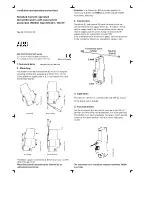
Powered by Safety
®
8
Equipment Description
01.4IB.50023A
PowlVac® Electrically Operated 15kV Ground and Test
per Long Island Railroad Specifications
The hinges of the three grounding contacts are
connected together by a ground bus
, which is in turn connected to a
heavy duty ground connection located on
the rear of the ground and test device frame
between the center and right phases. This
ground connection duplicates the ground
connection on the PowlVac
®
circuit breaker and
connects to the ground bus in the switchgear
compartment, providing a path to ground from
the ground making switch.
e. S
tored
e
nerGy
m
echAnISm
The lower front cover has cutouts and
apertures giving access to various operating
and levering-in mechanism indicating and
operating functions. Removal of the holding
screws allows the removal of the upper portion
of the front cover and the test port shutter
assembly, giving access to the mechanism
and its interlocks
, auxiliary switches
, charging motor
, and
motor cutoff switch
.
The ground making switch is closed and
opened by a stored energy mechanism
in which a gear motor is used to
compress a closing spring. During a closing
operation, the energy stored in the spring
is used to close the ground making switch
contacts, charge the opening springs and
overcome friction forces. When the ground
making switch is opened, the energy stored
in the opening spring and the kickoff springs
will open the contacts. Since the ground
making switch has no interrupting rating,
contact speed while opening is not important.
The motor, located on the inside of the lower
front cover at the left
is supported
from the lower front cover. Its output shaft
is screwed to a coupler which insert into the
eccentric drive shaft. This shaft is supported
in the needle bearings in the mechanism
frame side sheets and transmits the motor
torque from the left to the right side of the
mechanism.
When the motor is energized, the eccentric
shaft rotates and causes the driving arm links
to pivot about the camshaft
. The
drive pawl located on the links engages with
the ratchet wheel and rotates it. The ratchet
wheel is prevented from rotating backwards
by a holding pawl, which is supported on links
which project upwards from the camshaft.
To ensure correct synchronization of the drive
and hold pawls, the hold pawl links are located
by a threaded shaft which passes through
the lower front cover to the right of the
mechanism. The position of the holding pawls
is adjusted by a nut on the outer end of this
shaft.
As the ratchet wheel is rotated, projections
from its side faces will engage drive plates
attached to the camshaft and the camshaft will
rotate. Attached to the ends of the camshaft
are crank arms and pointing outward from
these are crank pins. These engage with the
front ends of the connecting rods
, the rear ends of which engage in
pins projecting from the spring compression
plate which straddles the main closing spring.
As the camshaft rotates, the connecting rods
pull the spring compression plate forward,
compressing the closing spring.
The ratchet wheel will drive the camshaft so
that the connecting rods go forward as far as
possible and then start to move to the rear. At
a certain point, the spring force will overcome
friction and resistance and start to rotate the
camshaft. At the same time, the pawls are
uncoupled from the ratchet wheel and the
motor cutoff switch is operated.










































